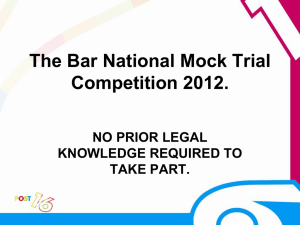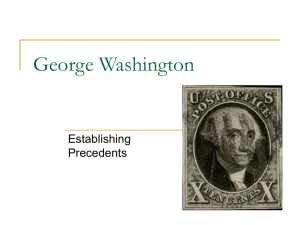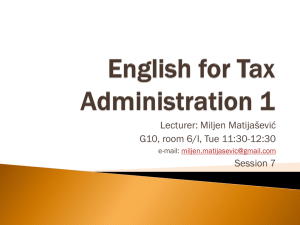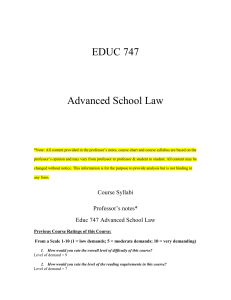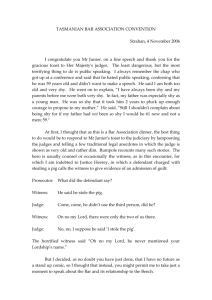Barristers
advertisement
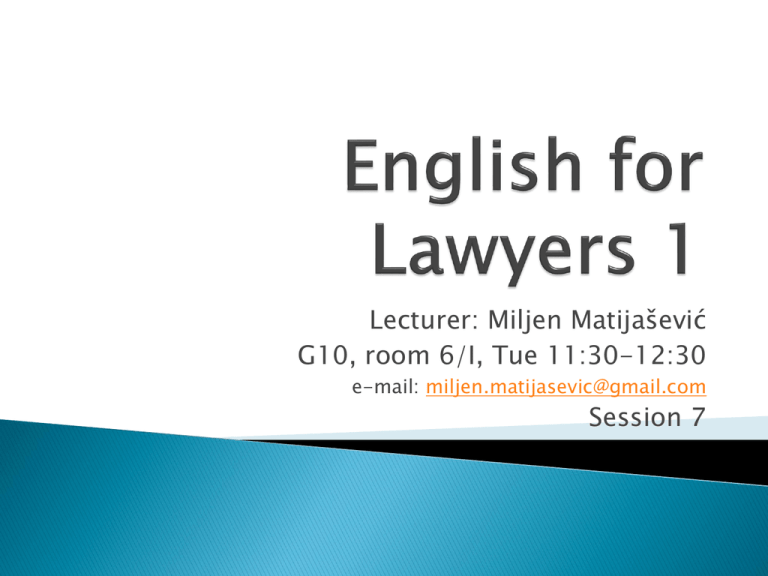
Lecturer: Miljen Matijašević G10, room 6/I, Tue 11:30-12:30 e-mail: miljen.matijasevic@gmail.com Session 7 1. Revision of the last session 2. The Legal Profession in England 3. Vocabulary work The Doctrine of Precedent 1. 2. 3. What types of precedent are there? What is the difference between them? What does it mean to follow the precedent and when is this done? What does it mean to distinguish the case? BIND - PERSUADE – APPLY – CITE 1. 2. 3. 4. That decision of the Court of Appeal is going to be .............. on the case we’ve got at trial just now. We need to be able to convince the judge that the rule in Meah v Roberts is .............. to this case. Can you check the case ..............? I think the year is wrong. Should we add to our argument that Edwards v Peck is a .............. precedent given the legal issues, although the judge isn’t .............. to follow it as it comes from a lower court? 1. 2. 3. 4. That decision of the Court of Appeal is going to be BINDING on the case we’ve got at trial just now. We need to be able to convince the judge that the rule in Meah v Roberts is APPLICABLE to this case. Can you check the case CITATION? I think the year is wrong. Should we add to our argument that Edwards v Peck is a PERSUASIVE precedent given the legal issues, although the judge isn’t BOUND to follow it it as it comes from a lower court? 1. 2. 3. 4. 5. 6. 7. 8. The emphasis on precedent .... strongly .... in English law. The legal system of the US .... in English Common Law. Magistrates' courts and county courts .... by precedents established in the High Court and above. High Court judges .... to give good reasons for departing from such precedents. Precedents .... in a slightly more flexible way in the criminal courts. The principle of law on which a precedent .... must be essential to the decision at hand. Some statements .... to be obiter dicta and are not binding as precedents. There is a danger of inflexibility if a precedent .... too slavishly. 1. 2. 3. 4. 5. 6. 7. 8. The emphasis on precedent IS strongly MARKED in English law. The legal system of the US IS ROOTED in English Common Law. Magistrates' courts and county courts ARE BOUND by precedents established in the High Court and above. High Court judges ARE EXPECTED to give good reasons for departing from such precedents. Precedents ARE TREATED in a slightly more flexible way in the criminal courts. The principle of law on which a precedent IS BASED must be essential to the decision at hand. Some statements ARE SAID to be obiter dicta and are not binding as precedents. There is a danger of inflexibility if a precedent IS FOLLOWED too slavishly. Unit 6 There are two branches of the legal profession in England, two types of legal practitioners representing clients: SOLICITORS BARRISTERS They have different training, functions, responsibilities, areas of expertise and rights In history, each type of attorney enjoyed various exclusive rights, but this has been gradually abolished since 1985 1a. University degree in law (LLB – Bachelor of Legal Letters) ◦ usually a three-year programme OR 1b. A bachelor’s degree (BA) in any subject + Graduate Diploma in Law (GDL) ◦ a one-year conversion course After completing an LLB or a GDL programme: 2a. Legal Practice Course (LPC) – for solicitors OR 2b. Bar Vocational Course (BVC) – for barristers ◦ both are one-year programmes, but can sometimes be taken over the course of two years primarily thought of as lawyers who can be contacted directly by members of the public direct contact with lay clients – people seeking legal advice or legal representation traditionally have the right of audience only in inferior courts generally perceived as general practitioners investigate the facts of the case, do the ‘legwork’ collect evidence, talk to witnesses, have contact with the police where necessary prepare briefs for barristers (all relevant documents and evidence necessary for trial) if the case needs to be tried at a higher court, they will instruct a barrister they also do non-contentious work, which refers to legal services which do not involve a court procedure E.g. conveyancing (prijenos prava vlasništva), drafting contracts and wills (sastavljanje ugovora i oporuka) intermediaries between lay clients and barristers Usually work in partnerships or incorporated law firms, sometimes employing a large number of solicitors This allows them to specialize in a certain field of the law, such as: commercial law, conveyancing, family law, probate (ostavina), employment, criminal law, accidents and personal injury, consumer protection, etc. Have the right of audience before lower (inferior) courts: magistrates’ courts and county courts May qualify for an advocacy certificate in the higher courts (this is a recent change, which reduces the gap between solicitors and barristers) ◦ SOLICITOR ADVOCATE After obtaining a law degree (LLB), future solicitors take a one-year Legal Practice Course (LPC) Upon completion they look for a training contract Serve two years as a trainee in a firm of solicitors In order to practise law must obtain an annual practising certificate issued by the Law Society Barristers are professional advocates – act as legal representatives (in criminal cases both for the defense and the prosecution if employed by the Crown Prosecution Service – CPS) Their work also involves drafting documents associated with court procedure, and giving specialist legal advice Traditionally, have had the right of audience in the higher courts Referred to as ‘counsel’ in the court of law Not allowed to form partnerships, but rather work as sole practitioners May share clerks, so that if one barrister is busy, another may replace him Usually specialize in a certain area of the law Their clients are solicitors. The do not usually have direct contact with lay clients. After obtaining a law degree (LLB), future barristers attend a Bar Vocational Course (BVC) As students, after making a certain number of attendances, i.e. dinners (referred to as ‘keeping terms’), they are called to the Bar by one of the Inns of the Court (barrister associations of medieval origin) The Inns used to be institutions providing training in common law to barristers. Today they are unincorporated institutions run by their senior members There are four Inns of the Court: Gray’s Inn, Lincoln’s Inn, Inner Temple and Middle Temple Their function today is to recruit and train new barristers The new barrister then competes to obtain a funded 12-month pupillage in chambers to get practical training PUPILLAGE – a non-practising six months (observation of professional activities under a pupil master) and a practising six months (supply of legal services and exercise of the right of audience). To gain a Full Qualification Certificate pupils must learn the rules of conduct and etiquette at the Bar, learn to prepare and present a case completely, etc. The Certificate is issued by the Bar Council If successful at pupillage, they can apply for a tenancy in chambers Tenants share common expenses and support services at their chambers at one of the Inns 1. 2. Years of experience as either a solicitor or a barrister is a prerequisite for becoming a judge Two levels of barristers: Junior Counsel and Queen’s Counsel (“Silks”) All practising barristers are junior counsel until or unless they have been designated Queen’s Counsel (QC) Minimum 10 years of standing (in practice 15) Solicitors can also apply to become QCs QCs expected to appear only in the most complex and important cases, but are always accompanied by at least one junior counsel QCs also known as Silks, as they wear a silk gown (not black like junior counsel) QCs enjoy privileges (sit closest to the judge and have the right to address the judge first) and are paid significantly higher fees The Silk system criticized because it does little to Only 10% of the Bar are QCs and many able barristers never advance Engaging a QC is hardly a guarantee of success Most barristers motivated to apply for the sake of prestige and significantly higher earnings improve legal services Impedes a system of ‘free market’ in the field of advocacy – QCs thought to have an unfair advantage ARGUMENTS IN FAVOUR OF FUSION Expense to the client Failures in communication between solicitor and barrister A selected barrister may be too busy at a given moment so the solicitor has to hire another, sometimes at the last minute ARGUMENTS AGAINST FUSION Barristers free from interruptions by clients; easier for them to detach themselves Barristers can focus on special skills needed for public speaking, addressing the judge and the jury, which eventually benefits the lay client – preserves the quality of advocacy Thank you for your attention!
